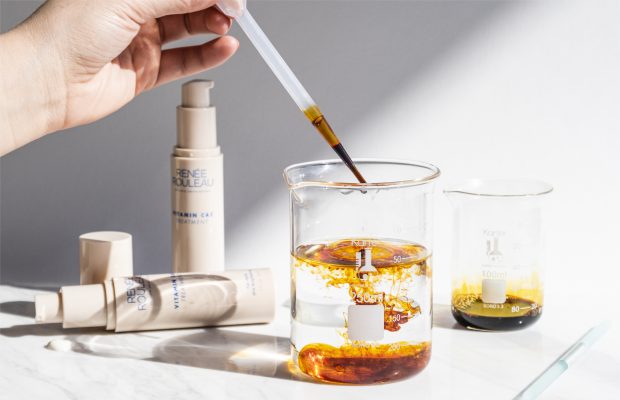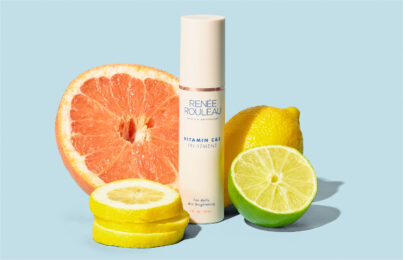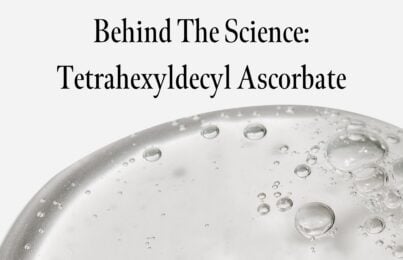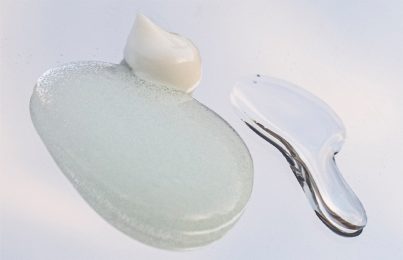By now, I’m sure you’ve heard countless dermatologists, beauty editors, and estheticians alike extol the skin benefits of vitamin C. It can protect our skin from aging caused by oxidative stress, boost collagen production, and encourage a brighter complexion by suppressing hyperpigmentation. For these reasons, it’s definitely a staple ingredient that I recommend almost everyone incorporate into their daily routine.
That said, vitamin C can have its downsides. The fact that it’s such a powerful antioxidant is also what can make it a very unstable ingredient. Vitamin C always wants to be reacting with something, so the minute it comes into contact with air, light, or water, it oxidizes and is no longer effective. (Have you ever had a vitamin C serum that turned brown? This is what happens when vitamin C oxidizes, and it’s definitely not a good thing.)
To make matters even more confusing, there are many different forms of vitamin C that can be found in skincare formulas, and they all have varying degrees of stability.
With all these caveats, it’s no wonder people are intrigued by the viral vitamin C experiment made popular on TikTok. The experiment involves adding a brown-colored iodine solution to a glass of water, stirring it, then adding a few drops of a vitamin C serum. The idea is that if the solution turns clear, the vitamin C serum must be effective. Vice versa, if it doesn’t turn clear, the vitamin C serum must be ineffective.
Unfortunately—like everything else when it comes to vitamin C—it’s not quite that simple. With the help of cosmetic chemist Valerie George, I’ll explain how vitamin C can change the color of iodine and why you shouldn’t be banking on this experiment to judge the efficacy of your serum. Here goes!
Why Does Vitamin C Turn Iodine Clear?
To understand why this reaction occurs, we need to delve into a bit of a chemistry lesson.
According to Valerie, iodine is what’s called a divalent molecule. This means it prefers to be in pairs and will always be found bound to another iodine molecule. When iodine molecules are paired up, they take on a brownish or purple color.
Simply put, when you add certain substances to an iodine solution, that divalent bond can become disrupted and the iodine molecules get split up. This is what causes a color change. (Remember putting iodine on a potato slice in grade school and watching it turn bright blue? This is a similar reaction that’s caused by iodine coming into contact with the starches in a potato.)
When Vitamin C is added to an iodine solution, it breaks apart the bond joining the iodine molecules causing the brown solution to become clear.
It’s Not Just Vitamin C That Causes This Reaction
The type of reaction we’re seeing in this TikTok experiment is what’s called a reduction. The reason I want to stress this is that it’s not just vitamin C that can reduce iodine. Iodine could be reduced by any type of antioxidant, including citric acid, lactic acid, or vitamin E. The reaction can also be caused by other types of ingredients that have reducing power, such as sodium hydroxide. Almost all cosmetic formulas have multiple ingredients that could probably contribute to a reduction, so when you’re doing this experiment it’s difficult to say if a reaction was caused strictly by the vitamin C in a product.
Not All Forms of Vitamin C Are Able to React With the Iodine
Another way in which this experiment is misleading? Just because a vitamin C serum doesn’t reduce the iodine doesn’t mean it won’t be effective when applied to the skin. The reason is that not all forms of vitamin C are going to be available to travel out of a skincare formula and into the iodine solution.
Take, for example, the Renée Rouleau Vitamin C&E Treatment. This product uses a stable, oil-soluble form of vitamin C called tetrahexyldecyl ascorbate (THD). The fact that THD is oil-soluble is one of the reasons it can penetrate into the skin really effectively, but it also means you wouldn’t see a reaction after dropping it into a glass of water where there aren’t any oils present.
Additionally, there are enzymes within the skin that slowly convert THD to pure ascorbic acid—another reaction that can’t be replicated in a glass of water.
All this to say, you can’t really look at how a complex vitamin C product reacts with iodine in a glass of water and directly translate that to how it will interact with your skin. These are ultimately two different scenarios involving completely different chemistries.
Bottom Line
While the vitamin C iodine experiment on Tik Tok is undoubtedly cool and visually satisfying, it’s misleading. It’s not an accurate method of measuring how effective a vitamin C serum is going to be when applied to your skin, and there are a number of other ingredients commonly found in skincare products that could cause the same color-changing reaction.
Next, need help when it comes to choosing the right vitamin C serum for your skin? Here are 5 things to look for.
Celebrity Esthetician & Skincare Expert
As an esthetician trained in cosmetic chemistry, Renée Rouleau has spent 35 years researching skin, educating her audience, and building an award-winning line of products. Her hands-on experience as an esthetician and trusted skin care expert has created a real-world solution — products that are formulated for nine different types of skin so your face will get exactly what it needs to look and feel its best. Trusted by celebrities, editors, bloggers, and skincare obsessives around the globe, her vast real-world knowledge and constant research are why Marie Claire calls her “the most passionate skin practitioner we know.”




Comments:
NICE & INFORMATIVE BLOG
Posted By: starbeauteparis |